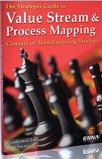Total Productive Maintenance
One reason that U.S. automotive plants had inventory banks between operations is that the
equipment of that time was not reliable. If the machines had been closely linked, as at Kamigo,
a breakdown on one machine would quickly stop the entire plant.
The solution for Toyota was Total
Productive Maintenance (TPM). TPM includes Preventive Maintenance in which components are
inspected and replaced before failure. It also includes thousands of engineering improvements to
increase Reliability, increase Mean-Time-Between Failure (MTBF) and decrease Mean Time to Repair
(MTTR).
These concepts did not originate at Toyota. The difference was the intensity and tenacity in
their application.
Layout
The Kamigo layout placed each machine adjacent to its upstream and downstream operations.
Work could then flow directly through a series of machining operations. There were no
significant inventory banks between operations. This eliminated the need for conveyors and fork
trucks.
Simple Transfer Devices
Kamigo used a wide variety of simple transfer devices that moved one part at a time from one
operation to the next. This was made feasible by the layout that placed these operations close
together.
Autonomation
Defects are another reason for inventory banks. An automated machine that begins to produce
defects may produce large quantities before being discovered and stopped. Just like a breakdown,
this single problem would quickly halt the entire plant without inventory banks to keep other
equipment running.
Autonomation uses a variety of ingenious
mechanisms to detect defects, jams and other problems and then halt the offending machine.
Autonomation is also used to control the small inventory between machines and shut down machines
that operate faster than their upstream or downstream neighbors.
Because of the lack of inventory and automatic stopping mechanisms, problems in any machine
quickly shut down other machines until the shutdown spread.
Jidoka
Jidoka was also used extensively at Kamigo. Jidoka
refers to the intentional stoppage of an entire production line when a defect or other problem
arises.
|
|
 
 A
Personal Recollection A
Personal Recollection
In 1983 I
visited Toyota's Kamigo Engine Plant. It was, at that time, the most efficient
automotive engine plant in the world. My first surprise was the American-built
machinery. Greenlee, Hydro-Mat and Cincinnati were among the names on equipment.
It seemed,
at first, like returning to the Ford plant where I had worked fifteen years before. But,
not quite: at Kamigo there were few fork trucks, no overhead conveyors and very few
workers.
As I looked
around for overhead conveyors, very common in U.S. auto plants, I noticed only a few
abandoned conveyor lines.
From an
elevated walkway, we saw almost the entire machining area. I observed only a half-dozen
or so workers, a single fork truck and no inventory banks.
What had
Toyota done to achieve this? The basics at Kamigo were similar to the usual descriptions
of Lean Manufacturing. The emphasis and specifics differed because this was engine
machining rather than assembly or stamping.
 
|
Problem-Solving Culture
This system only worked because of Toyota's extreme version of
problem-solving culture. In this
culture, work stoppages are not avoided-- they are deliberately provoked. A stoppage exposes a
problem. Solving the problem-- completely, permanently-- improves the operation and
sharpens the skills of employees. Approached properly, stoppages and the subsequent problem
solving are like capital investments. Immediate production is sacrificed for long-term
productivity.
References
MONDEN, YASUHIRO, Toyota Production System, Third
Edition, Industrial Engineering & Management Press, Atlanta, Georgia, USA, 1998.
HARRIMAN, FRED,
http://www.fredharriman.com/resources/documents/FHcom_Kaizen_Terminology_03.pdf, 2000.
OHNO, TAIICHI, Toyota Production System- Beyond Large
Scale Production, Productivity Press, 1988.
SPEAR, STEVEN, The Essence of Just In Time,
http://www.hbs.edu/research/facpubs/workingpapers/papers2/0102/02-020.pdf
|





